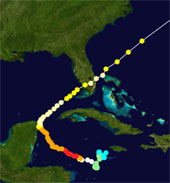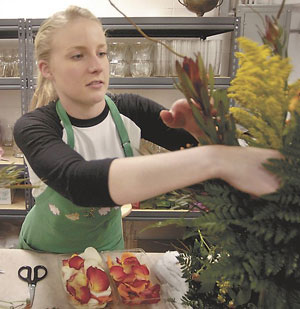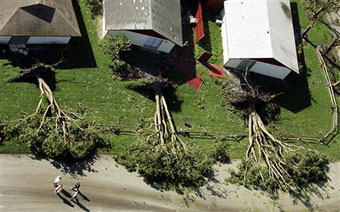Human Flower Project
Monday, November 21, 2005
In the Wake of Wilma
Florida growers and gardeners, and florists across the Southeast are still weathering the effects of Hurricane Wilma.
 Hurricane Wilma
Hurricane Wilma
October 2005
Image: Wikipedia
The third Category 5 storm of the season, Hurricane Wilma, had diminished to Category 3 by the time it sliced across South Florida October 24. That was plenty strong to inflict one billion dollars of damage to the state’s agriculture industry. Terry McElroy, speaking for the state Department of Agriculture, said, “We took another major hit … on top of the $2-to-$3 billion in damage we sustained last year from the four hurricanes during a six-week period.”
South Florida is a center for citrus, vegetables, ornamental plants and flowering annuals. Dave Self, a nurseryman and secretary of a local growers group, reported, “The hurricane basically destroyed every [flower farm] structure between Stuart and Homestead.” Joe Celeberti, of Loxahatchie, said, ““We got wiped out. Most of the greenhouses collapsed. We lost 100,000 flowers here.”
Elsewhere, plants that have survived are “getting leggy,” in pots, because the landscapers and big retail stores that would have bought them are cleaning up hurricane damage themselves.
 Stephanie Herron makes fall arrangements
Stephanie Herron makes fall arrangements
Petal ‘N Stem Florist, Beaufort, SC
Photo: Megan Lovett, for Beaufort Gazette
On up the Eastern seaboard, florists ran out of stock, no flowers or greenery—not even the old stand-by, leatherleaf fern, grown in South Florida. “You couldn’t get them flown out, you couldn’t get them trucked out. It was like a week of down time,” said one wholesaler in Walterboro, SC. Wilma disrupted “at least 2000 domestic and international flights” at Miami International Airport, the region’s huge floral transportation hub. Power outages also clobbered refrigeration systems, and it showed. One Beaufort, SC, florist complained that her daisy shipments “already look like they’re a week old, and they’re brand new.”
Flights are back on schedule now. Many flower growers have replanted already, and florists are replenishing their stock. It may take many years, though, to restore the region’s huge tropical trees.
 Downed trees, Ft. Lauderdale, Florida
Downed trees, Ft. Lauderdale, Florida
Photo: Wilfredo Lee, for AP
Eighty-three acres of the Fairchild Tropical Garden were damaged. “Pinecrest Gardens is now down to about 10 of the original cypress trees”; this year’s storms wiped out five of them. “Before Wilma, horticulturist Craig Morell had secured 2,000 orchids in trees around the grounds.” He estimated that clean up and restanding trees would cost $75,000, “if we can get someone here to do it before they die.’‘
The huge baobab at The Kampong of the National Tropical Botanic Garden also fell in the storm and now lies “covered with its own leaves and braches” to protect it from the Florida sun. It was “sown in 1907 from a Tanzanian seed,” fell over in Hurricane Cleo, 1965, and was first left for dead until “the late Catherine Sweeney, who by then owned The Kampong in Coconut Grove, hired a 70-foot flatbed truck and transplanted it to her grounds.”
The garden’s director, Larry Schokman, says every effort will be made to save the tree. “The ashes of people and pets have been scattered beneath it, Schokman said, ‘so we can’t leave it down.’’”
Cut-Flower Trade • Ecology • Florists • Gardening & Landscape • Permalink




